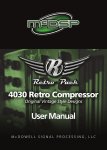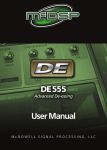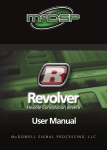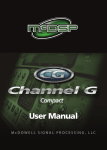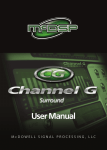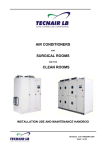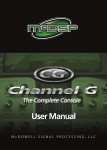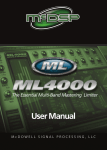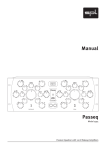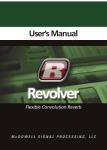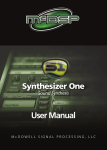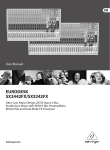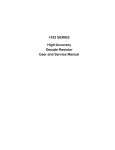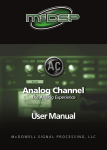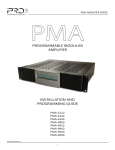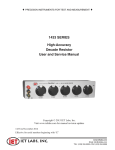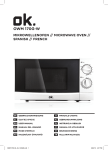Download User Manual
Transcript
4020 Retro EQ Original Vintage Style Designs User Manual McDOWELL SIGNAL PROCESSING, LLC McDSP 4020 Retro EQ Plug-In Manual McDSP McDowell Signal Processing, LLC 1300 Crittenden Lane #401 Mountain View, CA 94043 Support Email: [email protected] Technical Support: [email protected] World Wide Web: www.mcdsp.com Page ii McDSP 4020 Retro EQ Special Thanks to: • Rob Barrett Jr., our #1 customer • Customers who like innovation, not imitation. from the entire McDSP development team. Copyright Notice: Copyright 1998-2009 McDowell Signal Processing, Limited Liability Company All Rights Reserved. The McDowell Signal Processing, Limited Liability Company’s 4020 Retro EQ Plug-In and corresponding User’s Manual is copyrighted and all rights are reserved. Information in this document is subject to change without notice and does not represent a commitment on the part of McDowell Signal Processing, Limited Liability Company. This document may not, in whole or part, be copied, photocopied, reproduced, translated, or reduced to any electronic medium or machine-readable form for the purpose of resale without prior consent, in writing, from McDowell Signal Processing, Limited Liability Company. Trademarks: McDowell Signal Processing, Limited Liability Company is a trademark of McDowell Signal Processing, Limited Liability Company. Other brands and their products are trademarks of their respective holders and should be noted as such. Digidesign™ and Pro Tools™ are registered trademarks of Digidesign, Inc. mcdsp.com Page iii Table of Contents McDSP 4020 Retro EQ Plug-In Manual McDSP License Agreement Getting Started with the 4020 Retro EQ System Requirements Installing the 4020 Retro EQ Plug-In Installation on Mac OS X Installation on Windows XP and Vista Installation on VENUE D-SHOW systems Authorizing your McDSP Plug-Ins Authorizing with a pre-programmed iLok Smart Key Authorizing with an iLok License Card Authorizing with iLok.com Registering your McDSP Plug-In Using your McDSP Plug-Ins 4020 Retro EQ The Quick Start Tour: The 4020 Retro EQ Plug-In Retro Pack Overview Controls In/Out HF (High Frequency) HMF (High-mid Frequency) LMF (Low-mid Frequency) LF (Low Frequency) Displays Meters General Information Control Linking Automation Presets: Using the Presets and Making Your Own A Word on Preset Compatibility Page iv ii vi viii viii x x xii xiv xvi xvi xvi xx xxiii xxiii 24 25 25 27 27 27 27 27 28 28 28 28 28 29 29 29 McDSP 4020 Retro EQ Using the 4020 Retro EQ Plug-In 30 Basics High Pass Filter (HPF) Low Pass Filter (LPF) High Shelf EQ Low Shelf EQ Parametric EQ A Closer Look at the 4020 Retro EQ Plug-In Frequency Calibration HF-HMF Pairing LF-LMF Pairing Applications Air Guitar Drums Vocals Bass Fix the Mix 30 30 30 31 31 31 32 32 32 32 32 32 33 33 33 33 4020 Retro EQ Plug-In Reference Guide 34 4020 Retro EQ Specifications DSP Delay DSP Usage HD and HD Accel DSP hardware Maximum Instantiation Counts at 48kHz Percentage of DSP used by one instantiation at 48kHz mcdsp.com 34 35 35 35 35 36 Page v McDSP License Agreement The software described in this manual is furnished under a license agreement and may be used only in accordance with the terms of the agreement. McDowell Signal Processing, Limited Liability Company License and Warranty: The software which accompanies this license (the “Software”) is the property of McDowell Signal Processing, Limited Liability Company or its licensers and is protected by copyright law. While McDowell Signal Processing, Limited Liability Company continues to own the Software, you will have certain rights to use the Software after your acceptance of this license. Except as may be modified by a license addendum which accompanies this license, your rights and obligations with respect to the use of this Software are as follows: You May: • authorize 1 (one) copy of the Software on 1 (one) PACE Anti-Piracy iLok USB Smart Key, for use with no more than 1 (one) computer at any given time; • make copies of the Software for archival purposes, or copy the software onto the hard disk of your computer and retrain the original for archival purposes; • after written notice to McDowell Signal Processing, Limited Liability Company, transfer the Software on a permanent basis to another person or entity, provided that you retain no copies of the Software and the transferee agrees to the terms of this agreement You may not: • copy, duplicate, or reproduce the documentation which accompanies the Software for the purpose of resale; • sublicense, rent or lease any portion of the Software to a third party without expressed written permission from McDowell Signal Processing, LLC; • reverse engineer, de-compile, disassemble, modify, translate, make any attempt to discover the source code of the Software, or create derivative works from the Software; • make any attempt to circumvent any copy protection software; • use a previous version or copy of the Software after you have received a replacement set or an upgraded version as a replacement of the prior version, unless you donate a previous version of an upgraded version to a charity of your choice, and such charity agrees in writing that it will be the sole end user of the product , and that it will abide by the terms of this agreement. Unless you so donate a previous version of an upgraded version, upon upgrading the Software, all copies of the prior version must be destroyed. Page vi McDSP Limited Warranty: McDowell Signal Processing, Limited Liability Company warrants that the media on which the Software is distributed will be free from defects. Your sole remedy in the event of a breach of this warranty will be that McDowell Signal Processing, Limited Liability Company will, at its option, replace any defective media. McDowell Signal Processing, Limited Liability Company does not warrant that the Software will meet your requirements or that the operation of the Software will be uninterrupted or that the Software will be error-free. THE ABOVE WARRANTY IS EXCLUSIVE AND IN LIEU OF ALL OTHER WARRANTIES, WHETHER EXPRESSED OR IMPLIED, INCLUDING THE IMPLIED WARRANTIES OF MERCHANTABILITY, FITNESS FOR A PARTICULAR PURPOSE AND NON INFRINGEMENT. THIS WARRANTY GIVES YOU SPECIFIC LEGAL RIGHTS. YOU MAY HAVE OTHER RIGHTS, WHICH VARY FROM STATE TO STATE. Disclaimer of Damages: REGARDLESS OF WHETHER ANY REMEDY SET FORTH HEREIN FAILS OF ITS ESSENTIAL PURPOSE, IN NO EVENT WILL McDowell Signal Processing, Limited Liability Company BE LIABLE TO YOU FOR ANY SPECIAL, CONSEQUENTIAL, INDIRECT OR SIMILAR DAMAGES, INCLUDING ANY LOST PROFITS OR LOST DATA ARISING OUT OF THE USE OR INABILITY TO USE THE SOFTWARE EVEN IF McDowell Signal Processing, Limited Liability Company HAS BEEN ADVISED OF THE POSSIBILITY OF SUCH DAMAGES. SOME STATES DO NOT ALLOW THE LIMITATION OR EXCLUSION OF LIABILITY FOR INCIDENTAL OR CONSEQUENTIAL DAMAGES SO THE ABOVE LIMITATION OR EXCLUSION MAY NOT APPLY TO YOU. IN NO CASE SHALL McDowell Signal Processing, Limited Liability Company’s LIABILITY EXCEED THE PURCHASE PRICE FOR THE SOFTWARE. The disclaimers and limitations set forth above will apply regardless of whether you accept the Software. U.S. Government Restricted Rights: RESTRICTED RIGHTS LEGEND: Use, duplication, or disclosure by the Government is subject to restrictions as set forth in subparagraph (c) (1)(ii) of the Rights in Technical Data and Computer Software clause at DFARS 252.227-7013 or subparagraphs (c)(1) and (2) of the Commercial Software Restricted Rights clause at 48 CFR 52.227-19, as applicable, McDowell Signal Processing, Limited Liability Company, Mountain View, CA 94043 ([email protected]). General: This Agreement will be governed by the laws of the State of California. This Agreement may only be modified by a license addendum which accompanies this license or by a written document which has been signed both by you and McDowell Signal Processing, Limited Liability Company. Should you have any questions concerning this Agreement, or if you desire to contact McDowell Signal Processing, Limited Liability Company for any reason, please email: [email protected]. By downloading, using, or copying this Binary Software, Licensee agrees to abide by the intellectual property laws, and all other applicable laws of the U.S., and the terms of this License. Ownership of the software shall remain solely in McDowell Signal Processing, Limited Liability Company. mcdsp.com Page vii Getting Started with the 4020 Retro EQ Each McDSP plug-in is delivered inside an installer application, and uses the Interlok copy protection software to authorize each plug-in. This section describes how to install and authorize a McDSP plug-in. General system requirements are also described. System Requirements McDSP HD, Native, and LE plug-ins are compatible with Pro Tools™ HD, HD Accel TDM systems, as well as Pro Tools™ LE and Pro Tools™ M-Powered host based systems. McDSP plug-ins support Mac OS 10.4.x (Tiger), 10.5.x (Leopard), Windows XP and Vista and require Pro Tools 7.x, 8.x or greater. McDSP plug-ins require an iLok USB Smart Key. Configurations McDSP plug-ins are available in TDM, RTAS, and AudioSuite configurations. See individual products for specific available configuration sets. Applications Pro Tools™ 7.x, 8.x or higher is required for TDM, LE, and M-Powered systems. Additionally, a third party software application that supports the Digidesign TDM, RTAS, or AudioSuite plug-in standard may be supported. See http://www. digidesign.com/developers/plugin_info/ for more information. McDSP plug-ins are compatible with the entire Pro Tools™ 7 and 8 product line. Hardware McDSP plug-ins support any Digidesign or approved third party hardware supported in Pro Tools™ 7.x and 8.x. This includes HD, HD Accel, 003, and Mbox host based systems. All McDSP HD plug-ins, except Synthesizer One, also support the Digidesign VENUE D-SHOW systems. See http://www.digidesign.com/ compato/ for more specific information. The McDSP Mac versions are compatible with both Intel and PowerPC based computers. The McDSP Windows versions require an Intel Pentium 4 or greater processor.* Page viii Getting Started * McDSP Windows test machines are chosen to follow the Digidesign recommended systems guide, which currently is the Dell Precision™ Workstation 670 with 2.79 GHz Xeon processor. All products are guaranteed to run on that system. Older Intel processors (i.e. Pentium III and predecessors) and AMD processors are not officially supported, although some users have had limited success with newer AMD processors (i.e. Dual Opteron 1.79 GHZ, Athlon 64 2.20 GHz, and Athlon 64 XP 3700). None of the McDSP Windows product line will work with Pro Tools™ 5.x. Also note the McDSP Windows product line does not support MIX, although RTAS versions will work if they exist and the rest of your system (i.e. Pro Tools™ version and processor) is compatible. Please visit mcdsp.com for the latest information about compatibility. mcdsp.com Page ix Installing the 4020 Retro EQ Plug-In Installation on Mac OS X The 4020 Retro EQ plug-in Package includes this manual, ReadMe and Release Notes, a folder of presets for the 4020 Retro EQ plug-in, and the 4020 Retro EQ plug-in. Two copies of the 4020 Retro EQ Licensing Agreement are included one in this pdf manual and a second as a separate text file. The 4020 Retro EQ plug-in manual requires that Adobe Acrobat reader (or similar .pdf reader) is installed. Both online and boxed version will come with a 4020 Retro EQ installer that will automatically install the 4020 Retro EQ plug-in and its presets on your system. The authorization of the 4020 Retro EQ plug-in is still required after running the installer, and those steps are detailed in the following sections. Installing the 4020 Retro EQ plug-in and presets with the Installer: The online version of the package has been prepared for Internet delivery, and is transmitted as a compressed file in zip format (.zip). In Mac OS X 10.4.x or 10.5.x, simply double click the *.zip file to unpack the installer. The boxed plugin package purchased at your local dealer will be on CDROM. As with the online version, these ‘physical’ versions of the 4020 Retro EQ plug-in package should be copied into a local folder on your system. • Insert the McDSP ‘HD Disk,’ ‘Native Disk,’ or ‘LE Disk’ CDROM onto an available CDROM drive. • Navigate to the 4020 Retro EQ plug-in folder on the CDROM - the installer application is contained therein. • Run the 4020 Retro EQ plug-in Installer application to install (copy) the 4020 Retro EQ plug-in, presets, and documentation to a local folder on your system. The plug-in will be placed in the ‘Plug-Ins’ folder, and the presets will be placed in the ‘Plug-Ins Settings’ folder. • If a previous version of the 4020 Retro EQ plug-in (or other HD, Native, or LE version) was already in the plug-ins folder, it will automatically be updated (or replaced) by the installer. Page x Getting Started Re-installing the 4020 Retro EQ plug-in presets manually: In you wish to restore the factory default presets, it may be useful to know how to manually re-install only the presets. • Go to the ‘Plug-in Settings’ folder: • Root->Library->Application Support->Digidesign->Plug-in Settings • If Pro Tools™ has not already done so for you, create a folder called ‘4020 Retro EQ’. • Place a copy of the folder from the 4020 Retro EQ plug-in package called ‘Presets’ into the ‘4020 Retro EQ’ folder. The presets are now viewable (after restarting Pro Tools™) from the settings popup menu from the 4020 Retro EQ plug-in. Note it may be necessary to re-start Pro Tools™ in order for the newly added ‘Presets’ folder to be viewable from the Settings popup inside the 4020 Retro EQ plug-in window toolbar. mcdsp.com Page xi Installation on Windows XP and Vista The 4020 Retro EQ plug-in Package includes this manual, ReadMe and Release Notes, a folder of presets for the 4020 Retro EQ plug-in, and the 4020 Retro EQ plug-in. Two copies of the 4020 Retro EQ Licensing Agreement are included one in this pdf manual and a second as a separate text file. The 4020 Retro EQ manual requires that Adobe Acrobat reader (or similar .pdf reader) is installed. Both online and boxed version will come with a 4020 Retro EQ installer that will automatically install the 4020 Retro EQ plug-in and its presets on your system. The authorization of the 4020 Retro EQ plug-in is still required after running the installer, and those steps are detailed in the following sections. Installing the 4020 Retro EQ plug-in and presets with the Installer: The 4020 Retro EQ plug-in package purchased at your local dealer will be on CDROM and contain a Windows self extracting executable (.exe) similar to the online 4020 Retro EQ plug-in package prepared for Internet delivery. Both the boxed and online versions the 4020 Retro EQ plug-in executable file will automatically install the plug-in and its presets on your system. Double click the file to launch the installer which will install the 4020 Retro EQ plug-in, presets, and documentation. At any time after installation, you may access the documentation from the Windows ‘Start Menu’ under the ‘McDSP’ group. Authorization of the 4020 Retro EQ plug-in is still required after running the installer, and those steps are detailed in the following sections. Note that after installing new versions of the PACE iLok drivers with the 4020 Retro EQ plug-in installer, you will be prompted by the 4020 Retro EQ plug-in installer to reboot your system. If you are not prompted by the installer, there is no need to reboot. • Insert the McDSP ‘HD Disk,’ ‘Native Disk,’ or ‘LE Disk’ CDROM onto an available CDROM drive. • Navigate to the 4020 Retro EQ plug-in folder on the CDROM - the installer application is contained therein. • Run the 4020 Retro EQ plug-in Installer application to install the 4020 Retro EQ plug-in, presets, and documentation to a local folder on your system. The plug-in will be placed in the ‘Plug-Ins’ folder, and the presets will be placed in the ‘Plug-Ins Settings’ folder. • If a previous version of the 4020 Retro EQ plug-in (or other HD, Native, or LE version) was already in the plug-ins folder, it will automatically be updated (or replaced) by the installer. Page xii Getting Started Re-installing the 4020 Retro EQ plug-in presets manually: In you wish to restore the factory default presets, it may be useful to know how to manually re-install only the presets. • Go to the Plug-In Settings folder: • C:\Program Files\Common Files\Digidesign\DAE\Plug-In Settings\ • If Pro Tools™ has not already done so for you, create a folder called ‘4020 Retro EQ’. • Place a copy of the folder from the 4020 Retro EQ plug-in package called ‘Presets’ into the ‘4020 Retro EQ’ folder. The presets are now viewable (after restarting Pro Tools™) from the settings popup menu from the 4020 Retro EQ plug-in. Note it may be necessary to re-start Pro Tools™ in order for the newly added ‘Presets’ folder to be viewable from the Settings popup inside the 4020 Retro EQ plug-in window toolbar. mcdsp.com Page xiii Installation on VENUE D-SHOW systems The 4020 Retro EQ plug-in Package for VENUE D-SHOW systems includes presets for the 4020 Retro EQ plug-in and the 4020 Retro EQ plug-in. The 4020 Retro EQ Licensing Agreement is displayed when installing the product on D-SHOW. The pdf manual can be obtained by running the Mac OS X or Windows XP/ Vista version of the 4020 Retro EQ Pro Tools plug-in installer on any available computer. Both online and boxed versions will come with a VENUE compatible installer that will automatically install the 4020 Retro EQ plug-in and its presets on your system. The authorization of the 4020 Retro EQ plug-in is still required after running the installer, and those steps are detailed in the following sections. Note that all McDSP HD plug-ins, except Synthesizer One support the Digidesign VENUE D-SHOW system. Installing the 4020 Retro EQ plug-in and presets on VENUE with the ‘HD Disk’: The boxed 4020 Retro EQ plug-in package purchased at your local dealer will contain a CDROM titled ‘HD Disk’ that is specially formatted to work with your VENUE console. The VENUE installers are also available online as a compressed zip file download, however you will have to take additional steps to create your own VENUE installer CD-R, see additional instructions below before proceeding with these instructions. Both the boxed and online versions of the 4020 Retro EQ installer are the same and will install both the plug-in and its presets on your system. Note that after installing new versions of the PACE iLok drivers with the 4020 Retro EQ plug-in installer, you will need to reboot your system. You will not be prompted to reboot, and if you don’t you may see an error message saying “TPkd driver required, and a reboot. Please reboot or reinstall the software.’ If you see this message, simply reboot the console and try again. • Insert the McDSP ‘HD Disk’ CDROM onto the CD drive. Note that neither the McDSP ‘Native Disk’ nor the ‘LE Disk’ contains VENUE compatible installers. • Ensure your system is in ‘CONFIG’ mode, you cannot install plug-ins in ‘SHOW’ mode. • Navigate to the ‘OPTIONS’ page and then select the ‘PLUG-INS’ tab. • You should now see the 4020 Retro EQ plug-in available on the left hand side. • Select the 4020 Retro EQ plug-in and select ‘INSTALL.’ Page xiv Getting Started • If a previous version of the 4020 Retro EQ plug-in was already installed, it will be updated by the installer. Important note for FilterBank HD and CompressorBank HD on VENUE D-SHOW consoles: The first time you instantiate either of these plugins, a dialog box will appear asking you to choose a user interface preference. Choose the Knobs interfaces, as some of the Slider interfaces are too large for the VENUE display. Creating a VENUE D-SHOW Installer CD-R from the online zip file: If you do not have a boxed copy of 4020 Retro EQ with the included ‘HD Disk’ CDROM, you can still obtain a copy of the VENUE compatible installers from the www.mcdsp.com website. Once you have located and downloaded the latest VENUE compatible installers from the McDSP website, you will have to take several additional steps to create a VENUE compatible Installer CD-R. For your convenience, all VENUE compatible products are located in the same downloadable zip file, so you will only have to create one CD-R to install all compatible McDSP products. • Unzip the downloaded file and locate the folder named “TDM Plug-Ins” inside the unpacked folder. • Using any CD-R burning application, burn this folder and its contents to an ISO format CD-R. It is recommended that you use a brand new CD-R for this, and do not rewrite an older CD-R. • Once you have burned this folder to a CD-R, you should see it at the root level of the disk (i.e. “D:\TDM Plug-Ins”). Important: If the “TDM Plug-Ins” folder is not located at the root level of the CD-R or has been renamed, the VENUE console may not properly recognize the installer disk. • At this point, you can follow the ‘HD Disk’ installation instructions above to complete the installation. mcdsp.com Page xv Authorizing your McDSP Plug-Ins Authorizing with a pre-programmed iLok Smart Key McDSP bundles such as the Emerald Pack come with a pre-programmed iLok Smart Key. Simply insert the iLok into any available USB port on your computer. The iLok’s indicator light will illuminate when the iLok has a proper connection. The Plug-Ins included in the bundle require no further authorization steps. As with any iLok on your system it is recommended that your iLok be registered and synchronized with iLok.com Authorizing with an iLok License Card All McDSP Plug-Ins require that a valid authorization is present on your iLok USB Smart Key. McDSP Plug-ins that are purchased individually provide this authorization on a plastic License Card (about the size of a credit card), with a small punch-out iLok License Chip. After being separated from the License Card, this iLok License Chip is to be inserted into the ‘key slot’ of the iLok USB Smart Key in order to transfer the authorization from the License Card to the iLok USB Smart Key. Note that each License Card holds ONE Plug-In authorization. The following instructions detail this process Important Note: The Authorization Wizard will prompt the user to register their iLok USB Smart Key at iLok.com. iLok.com is a service offered by PACE Anti-Piracy, Inc. and this step is recommended but NOT REQUIRED by McDSP to complete the authorization of the Plug-In. If you choose to register your iLok USB Smart Key at iLok.com, care must be taken to record your ilok.com account information (i.e. write down your User ID and Password in a safe place). If your iLok.com account information is lost, the iLok cannot be registered to another account and unfortunately there is nothing McDSP can do to help you. See iLok. com for more details about the benefits of using PACE’s iLok.com service. Note: Images in this section are for illustration only, the actual product and screens will be the name of the product you are authorizing. Page xvi Authorizing Your McDSP Plug-Ins Authorizing a McDSP Plug-In from a License Card with the Authorization Wizard: The Authorization Wizard is used to install an authorization from a License Card to the iLok USB Smart Key. To use the Authorization Wizard for the Plug-In you purchase, perform the following steps: • Insert your iLok USB Smart Key into an available USB port. • On a Mac :Locate and launch the ‘Authorizer’ application found in the ‘Authorize’ folder in the Plug-In package for the McDSP Plug-In you purchased on the CD-ROM. • On Windows XP or Vista, just launch Pro Tools™ to authorize the individual McDSP Plug-In you purchased. Note: When authorizing the Plug-In on Windows XP or Vista with a new iLok USB Smart Key, you must insert the iLok USB Smart Key and complete the Windows ‘Found New Hardware Wizard’ before attempting to authorize the Plug-In. • Select the ‘Authorize’ button to be guided through the Authorization Wizard. Note: Selecting the ‘Quit’ button at any time will not authorize the Plug-In or allow it to be used for a trial period. If ‘Quit’ is selected, the Plug-In will not be available in the Pro Tools™ insert menu. • McDSP Plug-Ins require that the user personalize their copy of the Plug-In. A dialog is displayed soliciting this information. Note that the product registration card enclosed with the Plug-In MUST ALSO be filled out as well and returned to McDSP via mail (or fax to 707-2200994). This additional mail-in registration will entitle the user to future upgrades and advance information from McDSP. mcdsp.com Page xvii • Once the Plug-In is personalized, click the ‘Next’ button to continue. • Check the ‘Use License Card’ box and press the ‘Next’ button (figure 2.3). Note: Although the Authorization Wizard may appear to allow authorization by challenge/ response, that method is currently NOT SUPPORTED McDSP Plug-Ins. • Separate the small punch-out iLok License Chip (the removable metal and plastic tab) from the License Card by pushing the cutout up and out with your thumb. Do not force your finger downward. • The iLok License Chip may now be inserted into the ‘key slot’ of the iLok USB Smart Key (figure 2.6). If the iLok USB Smart Key does not appear to be present on the system, ensure the iLok USB Smart Key is connected to a valid USB port and that the green LED is lit inside the iLok USB Smart Key. To insert the License Chip into the iLok USB Smart Key, orient the iLok USB Smart Key’s USB end to the left, and the loop end to the upper right. Insert the metal chip end of the iLok License Chip (the License Chip tab should have the metal chip side facing up towards you, not down). You should be able to visually verify that the License Chip makes contact with the iLok USB Smart Key metal card reader. • The green LED in the iLok USB Smart Key will light when it is ready to receive and transmit data. • Upon inserting the iLok License Chip, a message will be displayed indicating the authorization was installed successfully. Click ‘Ok’ in the message dialog. Page xviii Authorizing Your McDSP Plug-Ins • Once the authorization is installed on the iLok USB Smart Key, a dialog is displayed prompting the user to register their iLok USB Smart Key at the www.ilok.com website. The iLok.com website was created to allow users to manage the software authorizations on their iLok USB Smart Key. THIS STEP IS NOT REQUIRED TO COMPLETE THE AUTHORIZATION OF MCDSP SOFTWARE. The registration of the iLok USB Smart Key to an iLok.com account can be bypassed by clearing the checkbox. The user may also choose to not be asked to register again. While iLok.com is a great resource for the iLok USB Smart Key, your iLok USB Smart Key may only be linked to one iLok.com account. That is, an individual iLok USB Smart Key can only be registered to one account at a time--but a single account can have multiple iLok USB Smart Keys. If the iLok.com account information is lost, the iLok USB Smart Key cannot be registered to another account. However, an iLok USB Smart Key may be transferred between accounts if all the authorizations have been transferred off the iLok USB Smart Key. Register the iLok USB Smart Key to an iLok.com account only when you are ready to retain all the needed iLok.com account information (User ID and Password). • A ‘Finished’ dialog is displayed showing what authorization method was used. • Click ‘Finish’ to exit the Authorization Wizard. mcdsp.com Page xix Authorizing with iLok.com Required for demo, upgrade, and replacement authorizations only iLok.com can be accessed from any Macintosh or PC with an Internet connection. You can do this at home, a friend’s, or at the office as long as there is an internet connection to access iLok.com--note that you don’t have to use your ProTools system computer! You simply use this computer to connect to iLok.com and transfer authorizations to your iLok Smart Key. The iLok Smart Key can then be moved to your ProTools system to complete authorization of your Plug-In. You will need: • A computer with an Internet connection. Either a Macintosh running OS 9.2 to OS 10.3 or a PC running Windows 98, ME, 2000, XP, or Vista • An iLok USB Smart Key • A valid iLok.com account. Visit www.iLok.com and set up a free account, if you have not already done so. 1) Download and install the required client software from iLok.com. 2) Download the desired McDSP Plug-In Installer from: http://www.mcdsp.com/support/updating.html 3) To receive an upgrade or replacement authorization, send email your iLok. com account information to: [email protected] To receive a demo authorization, email your iLok.com account information to: [email protected] Insert your iLok Smart Key into an available USB port and ensure that the indicator light is lit. Once your demo, upgrade, or replacement authorization is available for transfer, your iLok.com account will display the notice saying “You have licenses” on the upper left. Begin by selecting that link. Page xx Authorizing Your McDSP Plug-Ins The next page will display the pending licenses available for download. This page will also display the name of the Plug-In, its manufacturer, the type of authorization (demo, Not For Resale, or License), the date the authorization was deposited, and the date when the authorization will no longer be available for download from the server. Before any transfer of authorizations can take place, you must synchonize your iLok Smart Key with iLok. com. This may take a moment to process depending on your internet connection. Once you have synchronized your iLok, you can select the authorization(s) you wish to transfer to your iLok. If you have multiple iLoks connected to your computer, it is important to select the correct iLok you wish the authorizations to be transferred to. Then click “Download Licenses” to begin the process. Again, this may take a moment depending on your internet connection. When the transfer finishes you will be asked to confirm the completition of the transaction, thereby letting you know that the transfer was successful. mcdsp.com Page xxi If you wish to go back into your account and visually confirm the transaction for yourself, select “View iLoks” Then select the iLok you had the authorizations transferred to. That’s it! Dont forget to logout and move the iLok Smart Key to your ProTools System if you are using another computer for Internet access. Also, you may need to install a different version of the Plug-In if you are upgrading or replacing. Transferring Authorizations with iLok.com You may freely transfer any authorization within your iLok.com account between any of your registered iLok Smart Keys. If you wish to transfer an authorization out of your iLok.com account to a different user, it will require additional support from PACE Anti-Piracy, Inc and may be subject to a service fee or limited by manufacturer restrictions. Check the www.ilok.com website for updates and developments regarding iLok USB Smart Keys and the Pace Interlok Copy Protection system. Page xxii Authorizing Your McDSP Plug-Ins Registering your McDSP Plug-In To register your McDSP Plug-In, fill out and return the product registration card enclosed with the boxed Plug-In package by mail or fax 707-220-0994. Registering your product entitles you to future upgrades and advance information from McDSP. Each individual product must be registered (even if you have multiple copies), and the product must be registered to an individual, not an entity. If you represent a company it is your company’s responsibility to notify McDSP in writing if the individual who registered the Plug-In is no longer with the company. The Company must also be able to supply matching registration information to successfully transfer ownership of the Plug-In. Using your McDSP Plug-Ins Starting a McDSP Plug-In: Follow the installation, authorization, and registration instructions above, Launch Pro Tools™, and the McDSP Plug-In and its presets are ready for use. Refer to the Digidesign™ Pro Tools™ Reference Guide for details on general Plug-In operation such as automation. Exiting a McDSP Plug-In A McDSP Plug-In is exited by clicking on the desktop or other window in the DAE application running the Plug-In, closing the Plug-In window, or de-instantiating the Plug-In. Pro Tools™ sessions will save instantiated Plug-In configurations and their settings. Refer to the Digidesign™ Pro Tools™ Reference Guide for details on general Plug-In operation. Digidesign™ and Pro Tools™ are registered trademarks of Digidesign, Inc. mcdsp.com Page xxiii 4020 Retro EQ The 4020 Retro EQ plug-in, along with the rest of the McDSP Retro Pack plug-in product line, is an entirely new design based on more than a deacde of McDSP engineering experience. The Retro Pack plug-ins are highly stylized products (both visually and sonically), and through an elogant user interface, deliver a vintage gear experience. The 4020 Retro EQ is a four-band EQ and complimentary filter set. The HF and LF bands are shelving EQ, with two additional parametric EQs at the HMF and LMF bands. All EQ bands operate on a unique gain dependent variable slope/Q system for a smooth sound and increase selectivity at large boost/cut gain values. The HPF and LPF filters use a unique split-octave design giving a 12 dB / Oct slope near the selected frequency, and a maximum slope of 24 dB / Oct. All Retro plug-ins use a McDSP designed output stage topology to eliminate digital clipping at any output level and produce a smoother distortion characteristic. This feature is in addition to the analog saturation modeling that has made McDSP famous over the last decade. Features: • Unique original algorithms • EQ and filtering • Anti-Clip Output Stage Topology • Analog Saturation modeling • Double precision processing • Ultra low latency • Mono and stereo versions Page 24 McDSP 4020 Retro EQ The Quick Start Tour: The 4020 Retro EQ Plug-In Start Pro Tools™ and Instantiate the 4020 Retro EQ plug-In • Launch Pro Tools™ and Open a Pro Tools™ Session. • Verify the Display-> Mix Window Shows->Inserts View option is checked. • In one of the inserts of a stereo master fader, select the 4020 Retro EQ plugin. Note the 4020 Retro EQ plug-in will operate on master or regular audio tracks in mono or stereo versions. • If the insert selection does not show the 4020 Retro EQ plug-In, verify that the 4020 Retro EQ plug-in has been installed correctly. • For more information on starting Pro Tools™ and working with Plug-Ins, see Digidesign’s™ Pro Tools™ Reference Guide Retro Pack Overview The McDSP Retro Pack plug-ins are designed for the ultimate vintage vibe, using new and original algorithms based on McDSP’s decade of industry experience. Retro plug-ins are a line of ‘classics’ that can live up to their own name without emulating something else. The 4020 Retro EQ is a four-band EQ with high pass and low pass filtering options. mcdsp.com Page 25 HF (High Frequency) Shelving EQ LMF (Low Mid Frequency) Parametric EQ Page 26 HMF (High Mid Frequency) Parametric EQ LF (Low Frequency) Shelving EQ HPF (High Pass Filter) and LPF (Low Pass Filter) Input and Output Section In/Out Meters McDSP 4020 Retro EQ Controls In/Out The In/Out section controls input and output levels, along with phase control over the output stage. • In - input signal level adjustment (-24 to +24 dB) • Out - output signal level adjustment (-24 to +24 dB) • Phase - inverts the phase of the audio waveform HF (High Frequency) The 4020 EQ HF (high frequency) band is a shelving EQ with a unique variable slope design for a smooth sound at small gains, and a more selective response at large gains. • HF Gain - HF equalizer gain adjustment (+/- 15 dB) • HF Freq - HF equalizer frequency adjustment (4 - 16 kHz) HMF (High-mid Frequency) The 4020 EQ HMF (high-mid frequency) band is a parametric EQ with a unique variable slope design for a smooth sound at small gains, and a more selective response at large gains. • HMF Gain - HMF equalizer gain adjustment (+/- 15 dB) • HMF Freq - HMF equalizer frequency adjustment (1 - 8 kHz) LMF (Low-mid Frequency) The 4020 EQ LMF (low-mid frequency) band is a parametric EQ with a unique variable slope design for a smooth sound at small gains, and a more selective response at large gains. • LMF Gain - LMF equalizer gain adjustment (+/- 15 dB) • LMF Frequency - LMF equalizer frequency adjustment (250 Hz - 2 kHz) mcdsp.com Page 27 LF (Low Frequency) The 4020 EQ LF (low frequency) band is a gentle EQ with a unique variable slope design for a smooth sound at small gains, and a more selective response at large gains. • LF Gain - LF equalizer gain adjustment (+/- 15 dB) • LF Frequency - LF equalizer frequency adjustment (40 - 160 Hz) Displays Meters The 4020 Retro EQ Noise Filter has meters showing input signal output signal levels. These meters also can be used to confirm relative input and output levels are the same if desired. General Information To adjust any of the 4020 Retro EQ controls the user can: • Hold the <Command> key while dragging the slider for fine control, or • Click on the text box to highlight and edit the numeric value to get precise control (if a value outside the valid range is input, the control will default to the nearest allowed value when enter is hit) and hit <Enter>, or • Click on the text box to highlight the numeric value and then use the arrow keys to increase or decrease the numeric value, or • Use the <Option> key to bring all the controls to their default values, or • Use hardware controller surfaces supported by the 4020 Retro EQ plug-in including the Mackie HUI and Digidesign’s ICON™, ProControl™ and Control 24. Control Linking There is no control linking capability in the 4020 Retro EQ at this time. Page 28 McDSP 4020 Retro EQ Automation All 4020 Retro EQ Noise Filter controls are completely automatable. See the Digidesign™ Pro Tools™ Reference Guide, Automating Plug-Ins section. Presets: Using the Presets and Making Your Own The 4020 Retro EQ Noise Filter preset library demonstrates the wide range of applications the 4020 Retro EQ can be used. No preset will suit every application, and they have been provided as a guide for the user, and will hopefully inspire new ideas and ways to use this sophisticated plug-in. The presets can be accessed from the Pro Tools™ “Plug-In Librarian” and “PlugIn Settings” pop-up menus. To make and save your own presets, see the “Plug-In Librarian Functions” section of Digidesign‘s DigiRack Plug-Ins Guide. A Word on Preset Compatibility Presets for the 4020 Retro EQ configurations are interchangeable. Pro Tools™ is a registered trademark of Digidesign, Inc. mcdsp.com Page 29 Using the 4020 Retro EQ Plug-In The 4020 Retro EQ is a highly stylized combintation of equalzers and filters. The following sections cover basic operations of the EQ and filter algorithms in the4020 Retro EQ, provide a more in depth descript of some of the features of the 4020 Retro EQ, and outline some applciations of the 4020 Retro EQ plug-in. Basics There are three types of EQs included in the 4020 Retro EQ (high shelf, parametric, and low shelf), and two types of filters (high pass and low pass). High Pass Filter (HPF) High pass filters remove signals below the selected frequency, and pass the signals above the selected frequency unaffected (hence the term high pass). High pass filters have a slope measured in the amount of dB signal reduction (in dB) per frequency octave. Typically these values are in multiples of 6 dB / Oct. At the exact selected frequency of the high pass filter the signal reduction is usually - 3dB, however this can change based on filter design. FREQUENCY The 4020 Retro EQ high pass filter has a unique design element that gradually increases the filter slope from an initial slope of 6 dB / Oct to a maximum of 24 dB / Oct. Low Pass Filter (LPF) Low pass filters remove signals above the selected frequency, and pass the signals below the selected frequency unaffected (hence the term low pass). Low pass filters have a slope measured in the amount of dB signal reduction (in dB) per frequency octave. Typically these values are in multiples of 6 dB / Oct. At the exact selected frequency of the low pass filter the signal reduction is usually - 3dB, however this can change based on filter design. Page 30 FREQUENCY McDSP 4020 Retro EQ The 4020 Retro EQ low pass filter has a unique design element that gradually increases the filter slope from an initial slope of 6 dB / Oct to a maximum of 24 dB / Oct. High Shelf EQ High shelf EQ increases (or decreases) signal levels at and above the selected frequency. Shelving EQ can have a slope, or Q control, that determines the shelving EQ shape. dB The 4020 Retro EQ uses a unique design to alter the slope of the shelving EQ for a gradual slope at low gains, becoming steeper at high gains. FREQUENCY Low Shelf EQ Low shelf EQ increases (or decreases) signal levels at and below the selected frequency. Shelving EQ can have a slope, or Q control, that determines the shelving EQ shape. dB The 4020 Retro EQ uses a unique design to alter the slope of the shelving EQ for a gradual slope at low gains, becoming steeper at high gains. FREQUENCY Parametric EQ Parametric EQ increases (or decreases) signal levels at the selected frequency. Parametric EQ can have a Q control that determines the paramtric EQ width. A Q of 1.0 is about one frequency octave. A Q of 12.0 is about 1/12 a frequency octave, or one semi-tone. The 4020 Retro EQ uses a unique design to alter the Q (width) of the parametric EQ for a gradual slope at low gains, becoming steeper at high gains. mcdsp.com dB FREQUENCY Page 31 A Closer Look at the 4020 Retro EQ Plug-In Frequency Calibration The 4020 Retro EQ equalizer frequency ranges and defaults have been carefully chosen. A first pass in adjusting the tone of a track with the 4020 Retro EQ should be just using the gain controls on the four-band EQ section. After this initial pass, move the frequency controls to observe the changes they will produce. Note how the frequency controls in the 4020 Retro EQ are calibrated in octaves for a more musical response. HF-HMF Pairing A good EQ technique is to offset a boost (or cut) with a cut (or boost). Note the default frequency values for the HF and HMF sections in the 4020 Retro EQ. Try applying some postiive gain in the HF section along with some negative gain in the HMF section. The HF boost combined with the HMF cut can help promote the boost in the HF section in the mix, and possibly reduce the need for so much HF boost as well. LF-LMF Pairing What goes for the high frequencies goes for the low frequencies as well. A good EQ technique is to offset a boost (or cut) with a cut (or boost). Note the default frequency values for the LF and LMF sections in the 4020 Retro EQ. Try applying some postiive gain in the LF section along with some negative gain in the LMF section. The LF boost combined with the LMF cut can help promote the boost in the LF section in the mix, and possibly reduce the need for so much LF boost as well. Applications Air Guitar Many instruments, once recorded, can sound dull, as if a blanket was thrown over the microphone. The HF section of the 4020 Retro EQ can give up to 15 dB of gain to the upper frequency range, for a nice light / bright sound. Unlike other digital EQs, the 4020 Retro EQ Anti-clip output stage toplogy prevents digital clipping, so this technique can be used more generously than with other EQs. Page 32 McDSP 4020 Retro EQ Often it is a good idea to remove low end ‘thuds’ from guitar tracks at the same time this ‘air’ is applied. The high pass filter of the 4020 Retro EQ is perfect for such an application. Several guitar oriented presets are included with the 4020 Retro EQ. Drums The balance of the low end kick with the power of the snare and the percssive elements of the cymbals is difficult indeed. The smooth sound of the 4020 Retro EQ shelving EQs can beef up the low end and liven up the high end. Subtle (yet effective) adjustments in the mid range are accomplished through the two parametric sections. Several drum oriented presets are included with the 4020 Retro EQ. Vocals The 4020 Retro EQ gentle curves can give a vocal track that ‘polish’ it may need to cut through the mix. The high pass filter and/or low shelf EQ can remove some of the plosives. The two parametric EQs can adjust the tone of the vocal to better fix in with the rest of the tracks in the mix. Finally, the high shelf EQ can give the vocal that ‘sparkly top’ some may be searching for. Several vocal oriented presets are included with the 4020 Retro EQ. Bass The many combinations of the LF and LMF EQ band settings offer a wide variety of tones for the bass guitar and similar instruments. Signal boosts from the LF band used in conjunction with cuts from the LMF band give a good ‘meaty’ sound to many low end tracks. The tone variations from the HMF are HF bands should not be under estimated even when mixing instruments that are primarily considered ‘bass tracks’. Several bass oriented presets are included with the 4020 Retro EQ. Fix the Mix While generally designed for individual tracks and instruments, the 4020 Retro EQ gentle curves can make it a useful tool for overall ‘tone adjustment’. The Anti-Clip output stage is not a bad thing to have on the master either! mcdsp.com Page 33 4020 Retro EQ Plug-In Reference Guide 4020 Retro EQ Specifications Parameter Range Function IN -24 to +24 dB Input signal level adjustment OUT -24 to +24 dB Output signal level adjustment PHASE ON / OFF Inverts the phase of the audio waveform HF - (High Frequency) Gain -15 to + 15 dB HF equalizer gain adjustment FREQ 4 - 16 kHz HF equalizer frequency adjustment HMF - (High-mid frequency) Gain -15 to + 15 dB HMF equalizer gain adjustment FREQ 1 - 8 kHz HMF equalizer frequency adjustment lmF - (low-mid frequency) Gain -15 to + 15 dB LMF equalizer gain adjustment freq 250 Hz - 2 kHz LMF equalizer frequency adjustment lf - (low frequency) gain -15 to + 15 dB LF equalizer gain adjustment freq 40 - 160 Hz LF equalizer frequency adjustment HPF 25 to 400 Hz High pass filter frequency adjustment LPF 5 - 20 kHz Low pass filter frequency adjustment FILTERS Page 34 McDSP 4020 Retro EQ DSP Delay The delay incurred by any of the 4020 Retro EQ plug-in configurations is 3 (THREE) samples on HD systems. This is the absolute minimum number of delay samples a TDM plug-in can have. The McDSP plug-ins are designed in this manner to provide the user with the closest analog mixing console experience possible (analog inserts such as EQ and compression do not cause a processing delay when inserted into a track). DSP Usage HD and HD Accel DSP hardware The TDM versions of the 4020 Retro EQ Noise Filter plug-in configurations use a varying amount of DSP resources for each 4020 Retro EQ Noise Filter configuration. The table below is a listing of these DSP usages. DSP usage is shown in the Pro Tools™ System Usage window. Maximum Instantiation Counts at 48kHz Configuration 4020 Retro EQ Mono 4020 Retro EQ Stereo # Instantiations per DSP on HD systems 8 4 # Instantiations per DSP on HD Accel systems 16 8 All of the 4020 Retro EQ Noise Filter plug-in configurations can operate on the same DSP, depending on the configuration’s DSP requirements. See below for the percentages of a HD or HD Accel DSP used by a single instantiation of a 4020 Retro EQ Noise Filter plug-in. mcdsp.com Page 35 Percentage of DSP used by one instantiation at 48kHz Configuration 4020 Retro EQ Mono 4020 Retro EQ Stereo % of DSP used on HD systems 12% 24% % of DSP used on HD Accel systems 6% 12% Using the data provided in the above chart, the 4020 Retro EQ (stereo) and 4020 Retro EQ (stereo) plug-in configurations can share the same DSP. The 4020 Retro EQ Noise Filter supports some higher sample rates (88.2 kHz and 96 kHz). For 88.2 kHz and 96 kHz operation the dsp usage is roughly doubled (2x). Page 36 www.mcdsp.com Copyright 2009 by McDowell Signal Processing,LLC. All trademarks are property of their respective owners. McDSP is a trademark of McDowell Signal Processing,LLC.






































